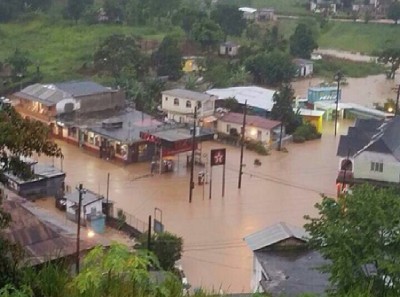The island of Jamaica experienced record rainfall amounts May 12th to 19th of 2017 following a prolonged period of drought. The island nation was severely impacted by heavy rains associated with a slow-moving trough (see Photo 1). The Jamaica Meteorological Service, in an emergency press conference held Tuesday May 16th, revealed that rainfall amounts received from May 12th to 15th exceeded the mean monthly rainfall for some parishes.

Photo 1: Cave Valley St. Ann flooded during heavy rains of May 16, 2017 – The Jamaica Gleaner.
In the parish of St Mary, for example, where historical monthly rainfall averages 148 mm, the recorded rainfall amount for this single event was 187 mm. Clarendon, hardest hit of the parishes, recorded a rainfall amount of 155 mm on the 15th (mean for the entire month is 139 mm). So, in just 4 days, the amount of rainfall exceeded the parish mean in St. Mary by over 26%, and in Clarendon by almost 12%.
For Jamaica, high-intensity rainfall events are forecast to become more frequent with climate change. This means that high rainfall amounts will be received over reduced periods of time when compared with historical events. With heavy rainfall, coastal areas are immediately impacted by run-off and waste accumulation. Flood waters are a transportation system for inland garbage to the sea. More often than not, buoyant trash released from Kingston Harbour end up down-shore along coastal bays and coves.
Figure 1: RMA Particle Tracking model output showing end-points of buoyant particles released along the mouth and shipping channel of the Kingston Harbour. Particle transport was tracked over an 11-day period. The full model loop can be seen here at MGIBlue.
This down-shore transport is depicted through MGIBlue’s Coastal Dynamics Modelling Lab in Figure 1 – a particle-tracking model showing buoyant particles released from the mouth of Kingston Harbour travelling along in-shore areas down the southeast coast into the Portland Bight Protected Area and even further along the south coast. This is typical for shorelines with nearby gullies, drains, and rivers as buoyant particles, once released from these land-based sources, will follow the flow and transport of water into coastal deposition sites.
With increased flooding and thus increased run-off, improper disposal of solid waste results in problems extending to coastal areas (see Photo 2). Jamaica is a coastal country with many livelihoods depending on coastal resources. Major industries such as tourism and fishing depend largely on healthy and aesthetically pleasing coastlines to thrive. 70% of Jamaica’s population live and or work in coastal areas, with 25% directly settled (JAMNAV©); while 90% of Jamaica’s GDP is produced in the coastal zone.

Photo 2: Garbage piled up along the beach adjacent to the Bournemouth Bath, off Michael Manley Boulevard 2016 – The Jamaica Gleaner.
Alarms have been raised about the amount of garbage dumped into gullies in the city. Of major concern are plastic and Styrofoam solid waste. With heavy rain events, these non-biodegradable products end up in coastal areas and oceans. This poses severe problems for marine organisms that may ingest or assimilate the garbage, become entangled or trapped therein. The ocean becomes the ultimate dumping ground for harmful and environmentally costly garbage.
With the launch of a multi-disciplinary recommendations Committee on the Use of Plastic and Styrofoam in Jamaica – chaired by Dr Parris Lyew-Ayee (Director of the Mona Geoinformatics Institute) – steps are being taken in the right direction towards tackling the root causes of the garbage problem rather than focusing on quick fixes that are not sustained. The improper disposals of garbage in gullies, as well as inefficient methods of garbage collection, are causing massive pollution of our coastlines and our oceans. Coastal clean-ups are useful but cannot be considered a solution to the problem as the source of the garbage is mainly inland. The root causes of the contamination problem must be addressed to combat the issues faced on the coastline. A useful approach in tackling the source of the problem is by targeting and changing people’s attitude towards the use and disposal of solid waste. Such a strategy will go a far way in improving the health and resilience of our coastal areas.
